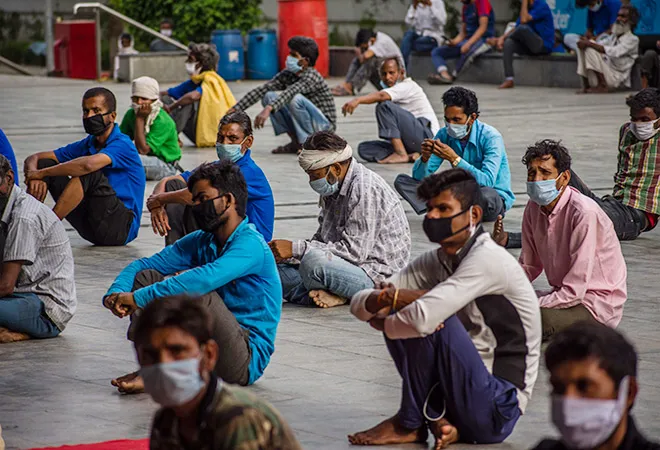
Overview of informal and migrant labour in India
The repercussions of the COVID-19 crisis for low-skilled migrant labourers, and informal workers, have been devastating. Loss of jobs, lack of social security, and being stranded in an alien city or state will be problems that the country will have to grapple with well beyond the post COVID-19 world. Article 22 of the Universal Declaration of Human Rights states that every member of society has a right to social security. The International Labour Organisation’s (ILO) fundamental principles and standards protect workers in various sectors. They include freedom of association, equal pay for equal work, safe working conditions, abolition of forced labour and sex-based discrimination, employment protection, provision of social security, protection of migrant workers, elimination of sexual harassment of women workers and others such facets.
The economic survey of 2018-2019 says that 93 percent workers are in the informal economy, while NITI Aayog’s ‘Strategy for New India @75’ in 2018 says that “India’s informal sector employs approximately 85 percent of all workers.” While sources may differ on the precise numbers, the enormity of the informal workforce is an accepted and known reality. These workers contribute to 50 percent of India’s national income and constitute a large part of the human capital base of the country. Considering the large percentage of the population trapped in the informal net, providing legal and economic protection will be a massive undertaking during this pandemic. While India has numerous policies for social security when it comes to education, healthcare, skilling, food security and pensions, most of these schemes are restricted to the organised sector.
The migration data from the 2011 census was analysed and released in the 2017 Economic Survey based on railway passenger traffic flows of the Ministry of Railways and new methodologies such as the Cohort-based Migration Metric (CMM). Estimates using the 2011 census and 2007-08 National Survey Sample place the share of migrants in the workforce to lie between 17 and 29 percent. There has been a steady increase in the number of internal migrants — annually, inter-state labour mobility averaged 5-6 million people between 2001 and 2011, therefore the inter-state migrant population comprises 60 million and inter-district migration is 80 million. Estimates of internal work-related migration for 2011-2016 shows that nine million people move between states.
Recent migration trends show that states like Maharashtra, Delhi, Tamil Nadu and Gujarat attract large swathes of migrants from the Hindi heartland of Uttar Pradesh, Bihar, and Madhya Pradesh. West Bengal too attracts a large number of migrants from the neighbouring states of Jharkhand, Uttar Pradesh, and Odisha. Given the fact that Maharashtra and West Bengal are the largest regional economies and regional magnets for migrants in the southern and western regions and the northern and eastern zones, respectively, here we particularly focus on how these two states have responded in safeguarding their migrants during the coronavirus scare.
Maharashtra’s plight
In terms of the occupation of the migrant labourers, people from drought-prone regions in Maharashtra migrate seasonally as labourers in brickmaking, construction, tile factories, and sugar factories in the urban areas. Migration contributed to 43.7 percent population growth in Mumbai between 1991 and 2001. However, internal migration rates have dipped in Maharashtra and surged in Tamil Nadu and Kerala since then, and Surat, Gujarat, is now also touted to be the counter migrant-magnet region to Mumbai.
Despite such measures, due to a misguided report of trains leaving for their home towns, on 14 April, a large crowd of migrant labourers and locals of the nearby slum gathered around Bandra station hoping to go to their native place and to protest against the type of food rations received.
Maharashtra seems to be the COVID-19 hotspot with rising cases and deaths. Given the state also accounts for one of the largest number of migrant workers, the state government announced a relief package of Rs 450 million for the provision of accommodation and food for its migrants. A status report filed by the Ministry of Home Affairs (MHA) in the Supreme Court proved that while the Kerala government operates over 65 percent of the total number of active shelters and relief camps for stranded migrant labourers, the Maharashtra government comes in second with 1,135 camps.
On 6 April, the Maharashtra Chief Minister announced that the government has set up 4,653 relief camps sheltering 454,142 migrant labourers and is providing food to 5,53,025 migrant labourers and homeless people across the state. Despite such measures, due to a misguided report of trains leaving for their home towns, on 14 April, a large crowd of migrant labourers and locals of the nearby slum gathered around Bandra station hoping to go to their native place and to protest against the type of food rations received. A similar incident happened in the neighbouring city of Surat where hundreds of textile workers also gathered to demand passages home.
West Bengal’s woes
In West Bengal, most of the migrants work as contract labour in construction sites, as house helps, drivers, etc. In fact, a large portion of these labourers account for the seasonal migration in the agricultural sector. Additionally, West Bengal is also characterised by a huge problem of illegal migrants from the porous India-Bangladesh borders.
As different circles have questioned the ‘ethics of care’ extended to migrant workers, West Bengal is not far behind amidst the distressing visuals of the migrant crisis across India. Kolkata's main inter-state rail terminus, the Howrah Station has turned into a pit of stranded migrant labourers as it is the main transit point for migrants from various districts in West Bengal and Northeast India as well. They are without adequate food, water and sanitation facilities.
The rural economy in West Bengal will be hit exponentially due to the crisis, as rural wages are set to fall post lockdown because of the oversupply of unskilled labour, as migrants try to return to their villages.
The early lockdown in Kolkata and some parts of state, before the nationwide lockdown, is considered to have ameliorated the mass exodus problem that was seen in the states of Uttar Pradesh and Bihar. On 26 March, the Chief Minister of Bengal wrote to 18 state governments to form a coordinated mechanism to rescue migrants across the country. The rural economy in West Bengal will be hit exponentially due to the crisis, as rural wages are set to fall post lockdown because of the oversupply of unskilled labour, as migrants try to return to their villages. Although measures such as opening of 27 night shelters in Kolkata for stranded migrants, strict instructions to employers for not deducting wages, distribution of meals, etc. are in place, a large part of the migrant distress, especially in rural Bengal remains substantially under reported.
Next steps?
The pandemic has jarringly exposed the fractures existing in the national attention given to safeguarding the rights of migrant labour. There is a glaring lack of focus on taking an updated stock of states’ migrant population and ensuring social security for them based on labour standards. There is scarce disaggregated internal migration data in India — the official statistics of number of migrant labourers mainly comes from the dated census reports that define a migrant — as a person who lives somewhere that is not their place of birth or their last place of residence.
A focused drive to collate up-to-date data on migrants within states is important in order to correctly gauge the funds required to provide adequate access to food supplies, housing, sanitation, and financial services — all factors that migrant seasonal workers find difficult to access currently. Lack of granular data is an important reason why the nation seems to have just woken up to the migrant crisis — nobody knows the magnitude of the situation, because the data we have is derived from models based on dated information.
States must now ensure that together with the growing interest in creating social security schemes for informal sectors, migrant labourers are differentiated and accounted for, due to added problems like unavailability of identity proof and lack of cooperation with the state of origin. A roadmap for cooperation between states to mitigate the stress on inter-state migrants should be enacted without waiting for another pandemic to force its hand.
The views expressed above belong to the author(s). ORF research and analyses now available on Telegram! Click here to access our curated content — blogs, longforms and interviews.




 PREV
PREV



